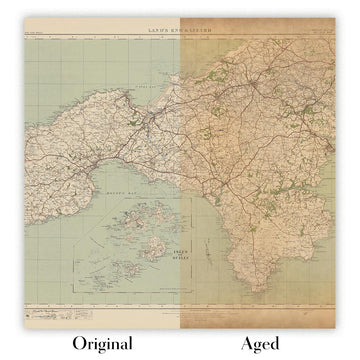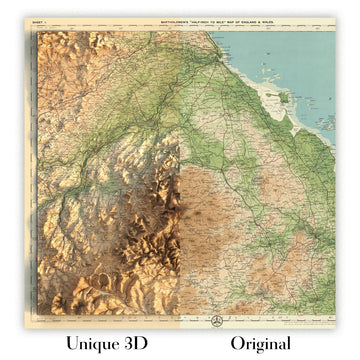

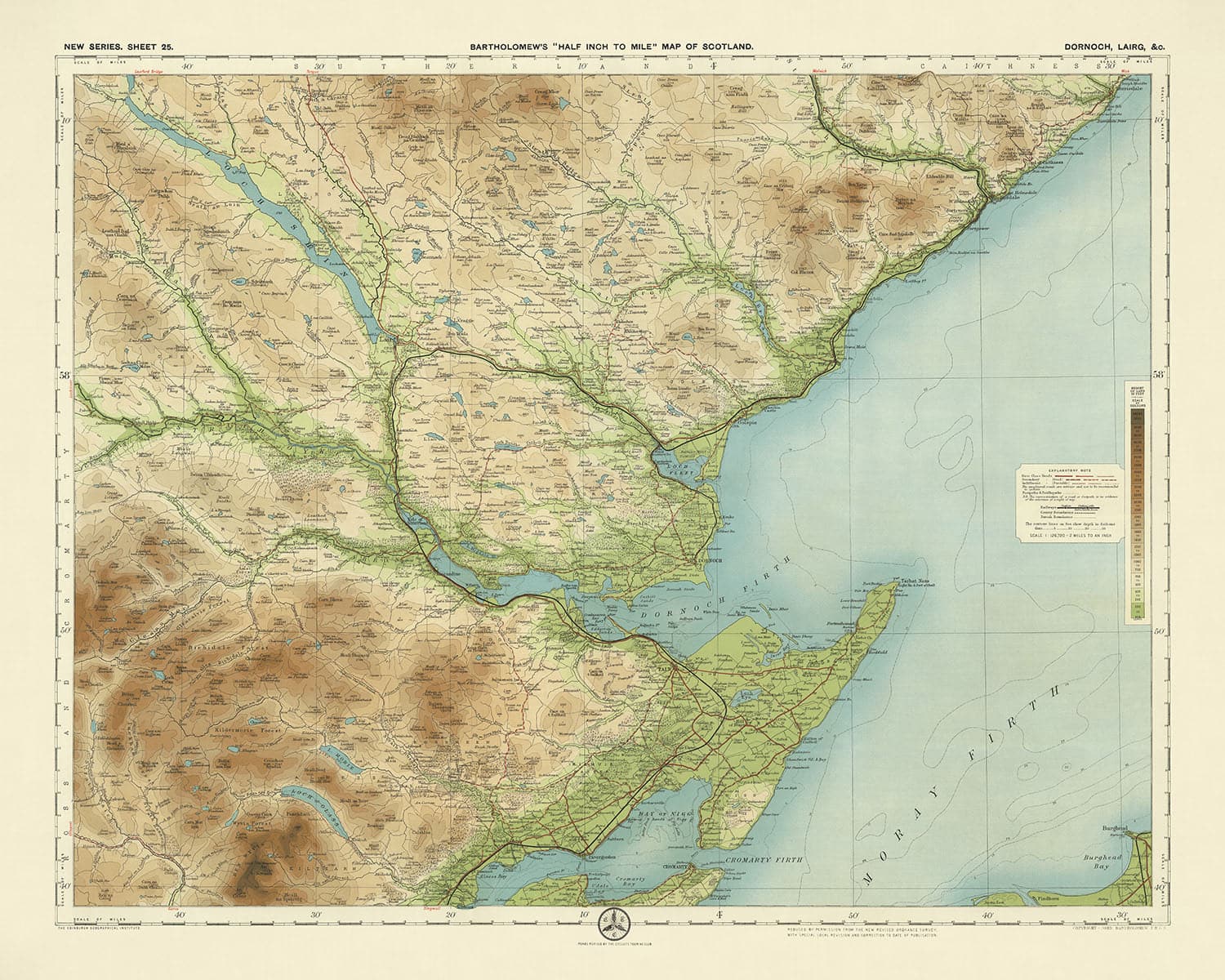

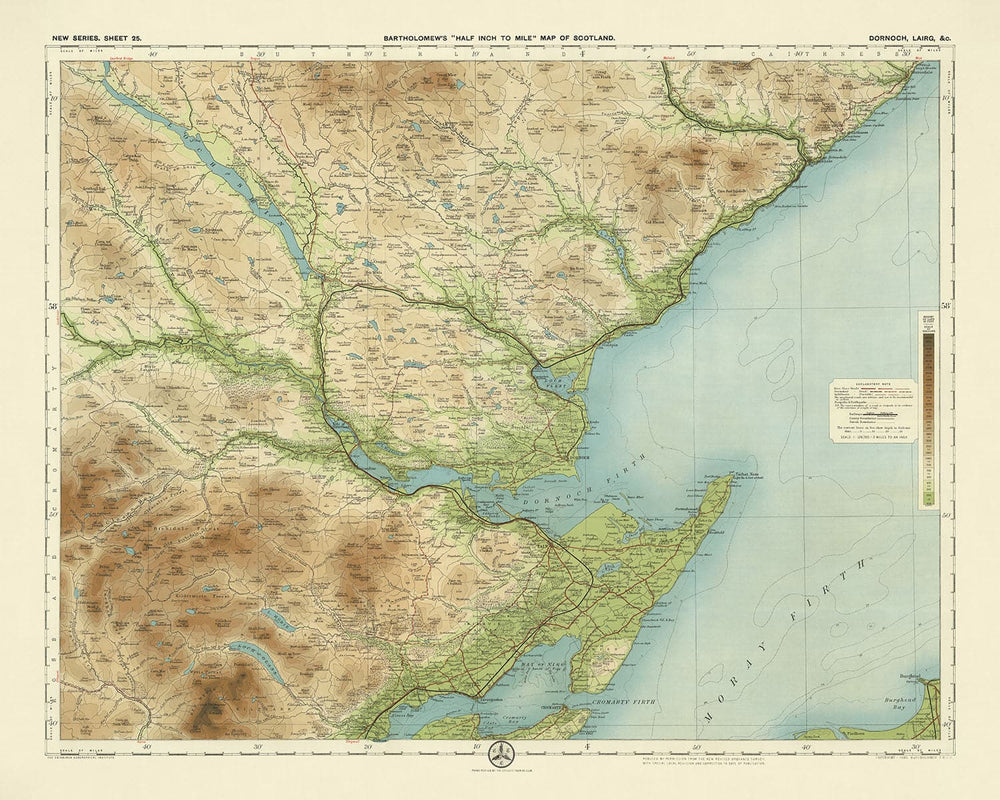

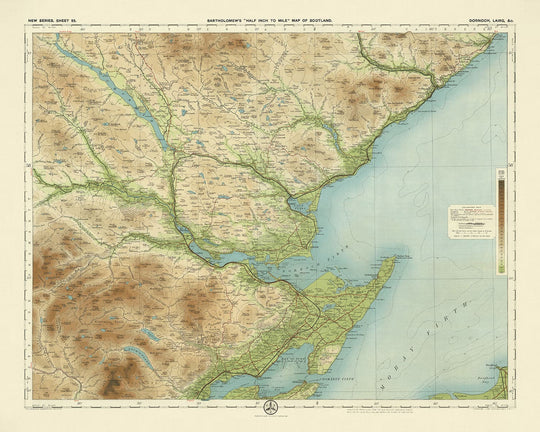







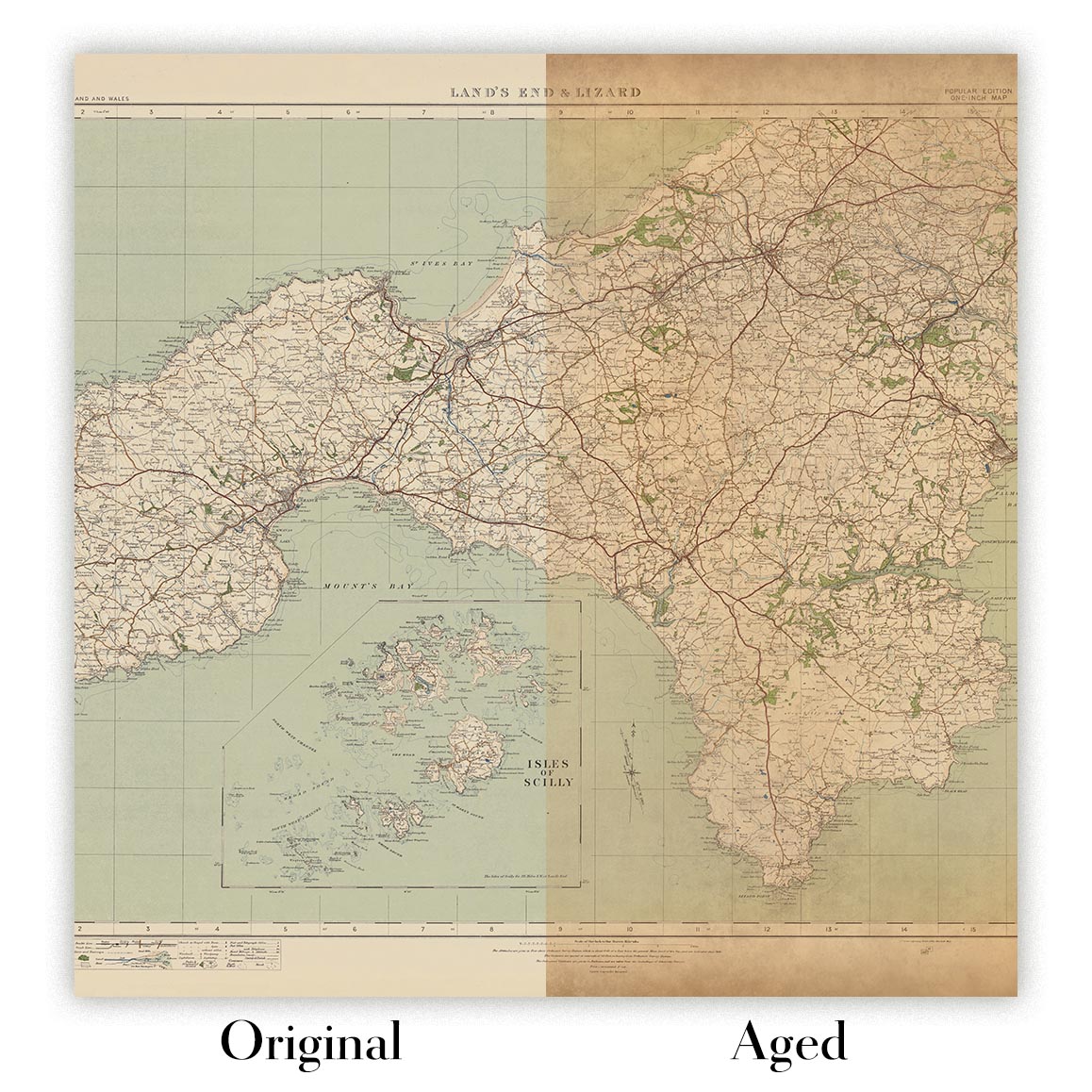



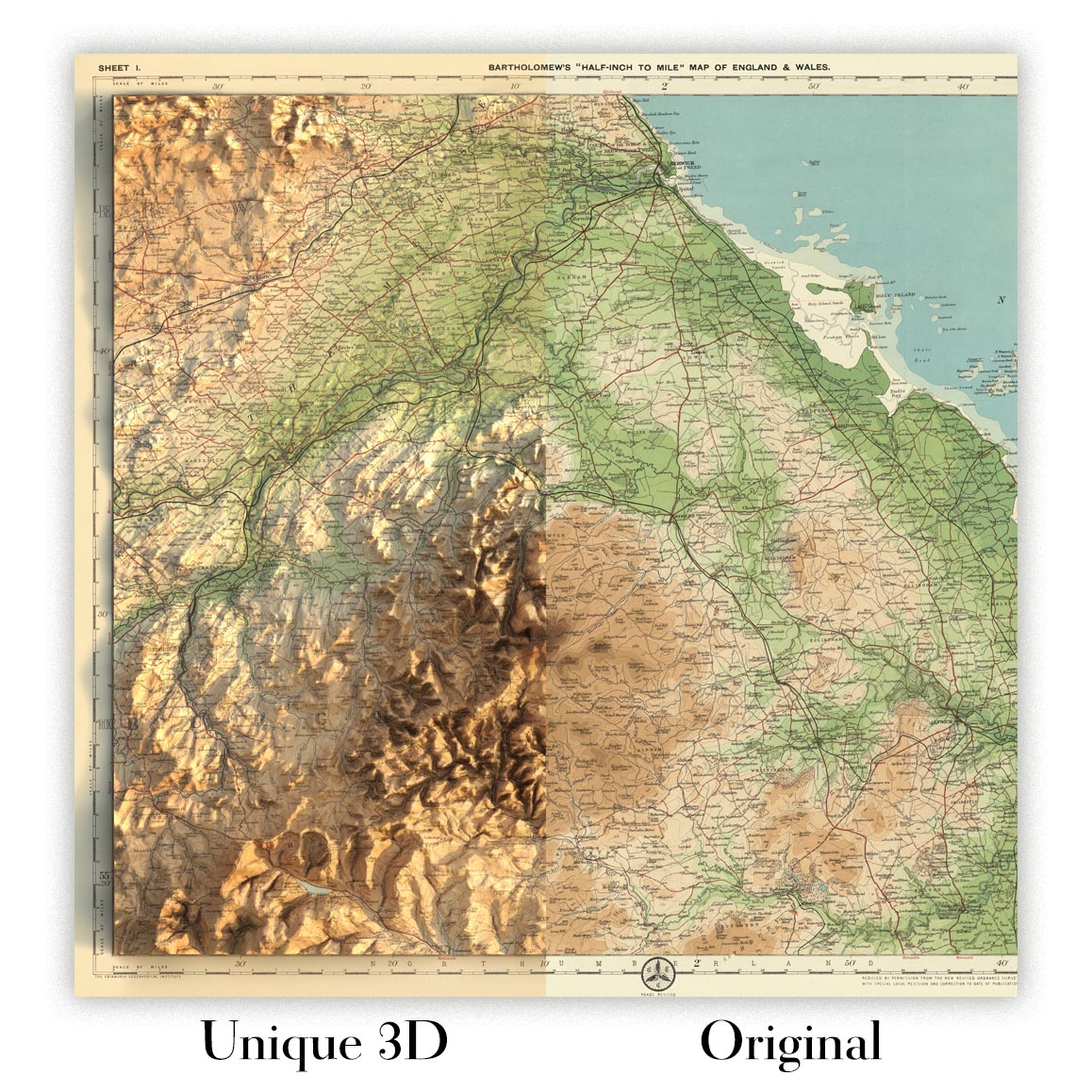

Old OS Map of Dornoch, Lairg, Sutherland by Bartholomew, 1901: Loch Shin, Dornoch Firth, Ben More Assynt


-
![]() Handmade in the USA
Handmade in the USA
-
FREE worldwide delivery in 2-3 days ⓘ
Free Christmas delivery in 2-3 days
Your map should be delivered in 2-3 working days with free delivery, worldwide.
We make maps by hand locally in 23 countries, including the USA
![]() . If you're buying a gift for someone in another country, we will make the map locally to them.
. If you're buying a gift for someone in another country, we will make the map locally to them.You will never pay import tax or customs duty.
Check the Christmas delivery guide for order deadlines.
Express delivery is available at checkout which can reduce the delivery time to 1-2 days.
Please note that personalised maps, and larger framed maps, can take longer to produce and deliver.
If you need your order to arrive by a certain date, contact me and we can discuss your options.
-
90 day money back guarantee
ⓘ
90 days to return and refund
Products can be returned within 90 days for a full refund, or exchange for another product.
For personalised and custom made items, we may offer you store credit or a non-expiring gift card, as we cannot resell personalised orders.
If you have any questions, get in touch. For more information, see our full returns & exchanges policy.

My maps are rare, museum-grade, restored old maps sourced from libraries, auction houses and private collections across the globe.
Framing & free personalisation available
1. Select your size
➢ Pick the closest size (above)
➢ Provide the exact size in millimetres
➢ Add to bag and checkout as normal
2. Frame & personalize your map
Make your map unique with framing, hand-drawn customisation, vintage ageing, pop art text, unique 3D styling and moreGift message & custom finish

If you want to add a gift message, or a finish (jigsaw, aluminium board, etc.) that is not available here, please request it in the "order note" when you check out.
Every order is custom made, so if you need the size adjusted slightly, or printed on an unusual material, just let us know. We've done thousands of custom orders over the years, so there's (almost) nothing we can't manage.
You can also contact us before you order, if you prefer!

- Handmade locally. No import duty or tax
- FREE Delivery. Arrives in 2-3 days
- Love it or your money back
- Questions? WhatsApp me any time
Own a piece of history
5,000+ 5 star reviews


Sheet 25 - Dornoch, Lairg, crafted by the esteemed J.G. Bartholomew in 1901, is a testament to the golden age of cartography. Bartholomew, often hailed as "the Prince of Cartographers," brought an unparalleled level of detail and artistry to his maps, making them both functional and visually captivating. This map, part of Bartholomew's flagship half-inch to the mile series, was designed with cyclists and tourists in mind, capturing the essence of early 20th-century Scotland. Its intricate layers of colour not only highlight the topographical nuances but also offer a vivid portrayal of the region's natural beauty.
The map's design is a masterclass in cartographic innovation, employing a subtle gradation of colour bands to represent different elevations. This technique allows for a clear and intuitive understanding of the landscape's relief, making it easy to visualize the undulating terrain of the Scottish Highlands. From the rolling hills to the majestic peaks of Ben More Assynt and Ben Klibreck, the map provides a comprehensive view of the region's diverse topography. The careful reduction of an Ordnance Survey map ensures that every detail is preserved, offering a snapshot of Scotland's geography as it was over a century ago.
The regions of Dornoch and Lairg, depicted in this map, are rich in both natural and historical significance. The serene waters of Loch Shin and Loch Fleet, the winding courses of the River Oykel and River Shin, and the expansive Dornoch and Cromarty Firths are all meticulously charted. These features not only define the physical landscape but also tell stories of the region's ecological and cultural heritage. The forests, such as Shin Wood and Balblair Wood, add to the map's verdant charm, highlighting areas of natural beauty that have long attracted visitors and nature enthusiasts.
In addition to its natural features, the map also details the infrastructure of the early 1900s, showcasing the railways and roads that connected these remote regions. The railways, in particular, were lifelines for the communities of Dornoch, Lairg, Bonar Bridge, Golspie, and Brora, facilitating trade and travel in an era before the advent of modern highways. The depiction of these routes offers a fascinating glimpse into the transportation networks of the time, reflecting the burgeoning industrial age and its impact on rural Scotland.
The historical context of this map adds another layer of intrigue. Created during a period of significant social and economic change, it captures a moment in time when Scotland was transitioning from its traditional ways of life to a more connected and industrialized society. The towns and settlements marked on the map, from the bustling port of Invergordon to the quaint village of Rogart, each have their own unique stories and histories. This map not only serves as a geographical guide but also as a historical document, preserving the legacy of a bygone era for future generations to explore and appreciate.
Cities and towns on this map
- Sutherland:
- Dornoch
- Lairg
- Bonar Bridge
- Golspie
- Brora
- Rogart
- Helmsdale
-
Tain (partially shown)
-
Ross and Cromarty:
- Alness (partially shown)
- Evanton (partially shown)
- Invergordon (partially shown)
Notable Features & Landmarks
- Natural Features:
- Loch Shin
- Loch Fleet
- Dornoch Firth
- Cromarty Firth
- River Oykel
- River Shin
- River Brora
- River Fleet
- Ben More Assynt
-
Ben Klibreck
-
Infrastructure:
- Railways connecting Dornoch, Lairg, and surrounding areas
-
Main roads and minor roads depicted
-
Forests and Wooded Areas:
- Shin Wood
-
Balblair Wood
-
Other Features:
- Various small lochs and rivers
- Distinctive colour gradients indicating elevation changes
Historical and design context
- A clear, attractive, and colourful map at the half-inch to the mile scale (1:126,720)
- Popular with cyclists and tourists, and became Bartholomew's flagship series
- Distinctive for using different layers of colour to represent landscape relief
- Subtle and innovative gradation of colour bands used to show land at different heights
- Based on a reduced Ordnance Survey map from the same period
- Created in 1901 by J.G. Bartholomew, a renowned Scottish cartographer known as "the Prince of Cartographers"
- Reflects the cartographic style and techniques of the early 20th century
- Provides insights into the geographical understanding and landscape of Scotland during that period
- Highlights the growing interest in outdoor activities and travel at the turn of the century
Please double check the images to make sure that a specific town or place is shown on this map. You can also get in touch and ask us to check the map for you.
This map looks great at every size, but I always recommend going for a larger size if you have space. That way you can easily make out all of the details.
This map looks amazing at sizes all the way up to 70in (180cm). If you are looking for a larger map, please get in touch.
Please note: the labels on this map are hard to read if you order a map that is 20in (50cm) or smaller. The map is still very attractive, but if you would like to read the map easily, please buy a larger size.
The model in the listing images is holding the 16x20in (40x50cm) version of this map.
The fifth listing image shows an example of my map personalisation service.
If you’re looking for something slightly different, check out my collection of the best old maps to see if something else catches your eye.
Please contact me to check if a certain location, landmark or feature is shown on this map.
This would make a wonderful birthday, Christmas, Father's Day, work leaving, anniversary or housewarming gift for someone from the areas covered by this map.
This map is available as a giclée print on acid free archival matte paper, or you can buy it framed. The frame is a nice, simple black frame that suits most aesthetics. Please get in touch if you'd like a different frame colour or material. My frames are glazed with super-clear museum-grade acrylic (perspex/acrylite), which is significantly less reflective than glass, safer, and will always arrive in perfect condition.
This map is also available as a float framed canvas, sometimes known as a shadow gap framed canvas or canvas floater. The map is printed on artist's cotton canvas and then stretched over a handmade box frame. We then "float" the canvas inside a wooden frame, which is available in a range of colours (black, dark brown, oak, antique gold and white). This is a wonderful way to present a map without glazing in front. See some examples of float framed canvas maps and explore the differences between my different finishes.
For something truly unique, this map is also available in "Unique 3D", our trademarked process that dramatically transforms the map so that it has a wonderful sense of depth. We combine the original map with detailed topography and elevation data, so that mountains and the terrain really "pop". For more info and examples of 3D maps, check my Unique 3D page.
For most orders, delivery time is about 3 working days. Personalised and customised products take longer, as I have to do the personalisation and send it to you for approval, which usually takes 1 or 2 days.
Please note that very large framed orders usually take longer to make and deliver.
If you need your order to arrive by a certain date, please contact me before you order so that we can find the best way of making sure you get your order in time.
I print and frame maps and artwork in 23 countries around the world. This means your order will be made locally, which cuts down on delivery time and ensures that it won't be damaged during delivery. You'll never pay customs or import duty, and we'll put less CO2 into the air.
All of my maps and art prints are well packaged and sent in a rugged tube if unframed, or surrounded by foam if framed.
I try to send out all orders within 1 or 2 days of receiving your order, though some products (like face masks, mugs and tote bags) can take longer to make.
If you select Express Delivery at checkout your order we will prioritise your order and send it out by 1-day courier (Fedex, DHL, UPS, Parcelforce).
Next Day delivery is also available in some countries (US, UK, Singapore, UAE) but please try to order early in the day so that we can get it sent out on time.
My standard frame is a gallery style black ash hardwood frame. It is simple and quite modern looking. My standard frame is around 20mm (0.8in) wide.
I use super-clear acrylic (perspex/acrylite) for the frame glass. It's lighter and safer than glass - and it looks better, as the reflectivity is lower.
Six standard frame colours are available for free (black, dark brown, dark grey, oak, white and antique gold). Custom framing and mounting/matting is available if you're looking for something else.
Most maps, art and illustrations are also available as a framed canvas. We use matte (not shiny) cotton canvas, stretch it over a sustainably sourced box wood frame, and then 'float' the piece within a wood frame. The end result is quite beautiful, and there's no glazing to get in the way.
All frames are provided "ready to hang", with either a string or brackets on the back. Very large frames will have heavy duty hanging plates and/or a mounting baton. If you have any questions, please get in touch.
See some examples of my framed maps and framed canvas maps.
Alternatively, I can also supply old maps and artwork on canvas, foam board, cotton rag and other materials.
If you want to frame your map or artwork yourself, please read my size guide first.
My maps are extremely high quality reproductions of original maps.
I source original, rare maps from libraries, auction houses and private collections around the world, restore them at my London workshop, and then use specialist giclée inks and printers to create beautiful maps that look even better than the original.
My maps are printed on acid-free archival matte (not glossy) paper that feels very high quality and almost like card. In technical terms the paper weight/thickness is 10mil/200gsm. It's perfect for framing.
I print with Epson ultrachrome giclée UV fade resistant pigment inks - some of the best inks you can find.
I can also make maps on canvas, cotton rag and other exotic materials.
Learn more about The Unique Maps Co.
Map personalisation
If you're looking for the perfect anniversary or housewarming gift, I can personalise your map to make it truly unique. For example, I can add a short message, or highlight an important location, or add your family's coat of arms.
The options are almost infinite. Please see my map personalisation page for some wonderful examples of what's possible.
To order a personalised map, select "personalise your map" before adding it to your basket.
Get in touch if you're looking for more complex customisations and personalisations.
Map ageing
I have been asked hundreds of times over the years by customers if they could buy a map that looks even older.
Well, now you can, by selecting Aged before you add a map to your basket.
All the product photos you see on this page show the map in its Original form. This is what the map looks like today.
If you select Aged, I will age your map by hand, using a special and unique process developed through years of studying old maps, talking to researchers to understand the chemistry of aging paper, and of course... lots of practice!
If you're unsure, stick to the Original colour of the map. If you want something a bit darker and older looking, go for Aged.
If you are not happy with your order for any reason, contact me and I'll get it fixed ASAP, free of charge. Please see my returns and refund policy for more information.
I am very confident you will like your restored map or art print. I have been doing this since 1984. I'm a 5-star Etsy seller. I have sold tens of thousands of maps and art prints and have over 5,000 real 5-star reviews. My work has been featured in interior design magazines, on the BBC, and on the walls of dozens of 5-star hotels.
I use a unique process to restore maps and artwork that is massively time consuming and labour intensive. Hunting down the original maps and illustrations can take months. I use state of the art and eye-wateringly expensive technology to scan and restore them. As a result, I guarantee my maps and art prints are a cut above the rest. I stand by my products and will always make sure you're 100% happy with what you receive.
Almost all of my maps and art prints look amazing at large sizes (200cm, 6.5ft+) and I can frame and deliver them to you as well, via special oversized courier. Contact me to discuss your specific needs.
Or try searching for something!
This service is currently unavailable,
sorry for the inconvenience.
Pair it with a frame
Frame options are for visualization purposes only.
FRAME STYLE
MATTING SIZE
BUILDING YOUR EXPERIENCE
powered by Blankwall
Take a few steps back and let your camera see more of the scene.
powered by Blankwall
Was this experience helpful?
Sheet 25 - Dornoch, Lairg, crafted by the esteemed J.G. Bartholomew in 1901, is a testament to the golden age of cartography. Bartholomew, often hailed as "the Prince of Cartographers," brought an unparalleled level of detail and artistry to his maps, making them both functional and visually captivating. This map, part of Bartholomew's flagship half-inch to the mile series, was designed with cyclists and tourists in mind, capturing the essence of early 20th-century Scotland. Its intricate layers of colour not only highlight the topographical nuances but also offer a vivid portrayal of the region's natural beauty.
The map's design is a masterclass in cartographic innovation, employing a subtle gradation of colour bands to represent different elevations. This technique allows for a clear and intuitive understanding of the landscape's relief, making it easy to visualize the undulating terrain of the Scottish Highlands. From the rolling hills to the majestic peaks of Ben More Assynt and Ben Klibreck, the map provides a comprehensive view of the region's diverse topography. The careful reduction of an Ordnance Survey map ensures that every detail is preserved, offering a snapshot of Scotland's geography as it was over a century ago.
The regions of Dornoch and Lairg, depicted in this map, are rich in both natural and historical significance. The serene waters of Loch Shin and Loch Fleet, the winding courses of the River Oykel and River Shin, and the expansive Dornoch and Cromarty Firths are all meticulously charted. These features not only define the physical landscape but also tell stories of the region's ecological and cultural heritage. The forests, such as Shin Wood and Balblair Wood, add to the map's verdant charm, highlighting areas of natural beauty that have long attracted visitors and nature enthusiasts.
In addition to its natural features, the map also details the infrastructure of the early 1900s, showcasing the railways and roads that connected these remote regions. The railways, in particular, were lifelines for the communities of Dornoch, Lairg, Bonar Bridge, Golspie, and Brora, facilitating trade and travel in an era before the advent of modern highways. The depiction of these routes offers a fascinating glimpse into the transportation networks of the time, reflecting the burgeoning industrial age and its impact on rural Scotland.
The historical context of this map adds another layer of intrigue. Created during a period of significant social and economic change, it captures a moment in time when Scotland was transitioning from its traditional ways of life to a more connected and industrialized society. The towns and settlements marked on the map, from the bustling port of Invergordon to the quaint village of Rogart, each have their own unique stories and histories. This map not only serves as a geographical guide but also as a historical document, preserving the legacy of a bygone era for future generations to explore and appreciate.
Cities and towns on this map
- Sutherland:
- Dornoch
- Lairg
- Bonar Bridge
- Golspie
- Brora
- Rogart
- Helmsdale
-
Tain (partially shown)
-
Ross and Cromarty:
- Alness (partially shown)
- Evanton (partially shown)
- Invergordon (partially shown)
Notable Features & Landmarks
- Natural Features:
- Loch Shin
- Loch Fleet
- Dornoch Firth
- Cromarty Firth
- River Oykel
- River Shin
- River Brora
- River Fleet
- Ben More Assynt
-
Ben Klibreck
-
Infrastructure:
- Railways connecting Dornoch, Lairg, and surrounding areas
-
Main roads and minor roads depicted
-
Forests and Wooded Areas:
- Shin Wood
-
Balblair Wood
-
Other Features:
- Various small lochs and rivers
- Distinctive colour gradients indicating elevation changes
Historical and design context
- A clear, attractive, and colourful map at the half-inch to the mile scale (1:126,720)
- Popular with cyclists and tourists, and became Bartholomew's flagship series
- Distinctive for using different layers of colour to represent landscape relief
- Subtle and innovative gradation of colour bands used to show land at different heights
- Based on a reduced Ordnance Survey map from the same period
- Created in 1901 by J.G. Bartholomew, a renowned Scottish cartographer known as "the Prince of Cartographers"
- Reflects the cartographic style and techniques of the early 20th century
- Provides insights into the geographical understanding and landscape of Scotland during that period
- Highlights the growing interest in outdoor activities and travel at the turn of the century
Please double check the images to make sure that a specific town or place is shown on this map. You can also get in touch and ask us to check the map for you.
This map looks great at every size, but I always recommend going for a larger size if you have space. That way you can easily make out all of the details.
This map looks amazing at sizes all the way up to 70in (180cm). If you are looking for a larger map, please get in touch.
Please note: the labels on this map are hard to read if you order a map that is 20in (50cm) or smaller. The map is still very attractive, but if you would like to read the map easily, please buy a larger size.
The model in the listing images is holding the 16x20in (40x50cm) version of this map.
The fifth listing image shows an example of my map personalisation service.
If you’re looking for something slightly different, check out my collection of the best old maps to see if something else catches your eye.
Please contact me to check if a certain location, landmark or feature is shown on this map.
This would make a wonderful birthday, Christmas, Father's Day, work leaving, anniversary or housewarming gift for someone from the areas covered by this map.
This map is available as a giclée print on acid free archival matte paper, or you can buy it framed. The frame is a nice, simple black frame that suits most aesthetics. Please get in touch if you'd like a different frame colour or material. My frames are glazed with super-clear museum-grade acrylic (perspex/acrylite), which is significantly less reflective than glass, safer, and will always arrive in perfect condition.








